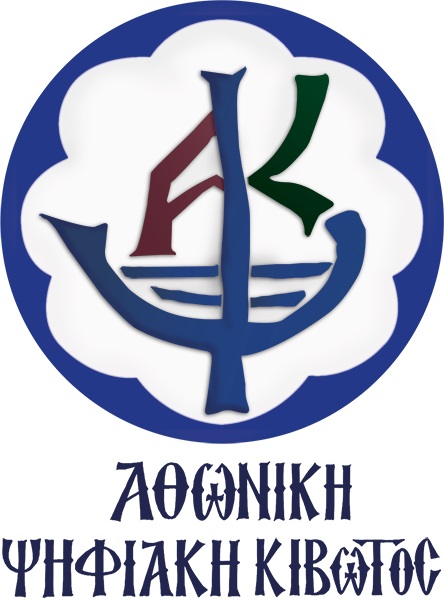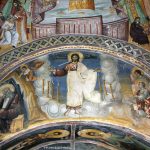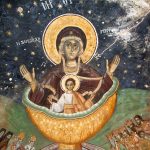In The Cathedral
At about the same time as the addition of the entrance nave and the bell tower to the cathedral, the decision makers at the Monastery provided for the fresco painting of its interior. This decoration was executed by different workshops of artisans in three consecutive phases, which correlated with the three-part plan of the cathedral.
It is not known whether or not a prior phase of decoration had been undertaken during the 150 years which had passed since the construction of the central nave, but in 1716, the initial work was executed by the artisan workshop of the hieromonk-artist Damaskinos of Ioannina.
Since the beginning of the 18th century, the monk Damaskinos had been the most productive painter of monumental art on Mt Athos, while at the same also known for his portable icons. At first he worked as a member of a workshop which was responsible for the fresco painting of small churches and chapels in the Chilandarios and Vatopedios monasteries. Later, he worked autonomously, and then as the leader of a workshop. After having completed one assignment in a small chapel, he won the acceptance of the Athonites, who trusted him with large-scale works (e.g. the refectory at the Docheiarios Monastery, and the entrance nave to the cathedral at the Vatopedios Monastery). The frescoes of the cathedral of Karakallou Monastery are the work of his maturity. Four years later, he completed his last interior work, the Koukouzelissas church in the Great Lavras Monastery.
As can be seen in all his works, Damaskinos has a Master’s relationship with painting, based on experience with and knowledge of iconic prototypes created by the great Cretan artists, in terms of both technique and structure of the painting. The fresco painting program of the church is based on general principles which were depicted in the frescoes of the Athonite cathedrals in the 16th century. The core of the program is a particular, extensive cycle of scenes from the life of Christ, depicting more than 50 scenes from the Book of Gospels up until the Ascension, which dominates all the surfaces of the dome. All the other representations are chosen for the purpose of focusing attention on the main cycle of events by serving as dogmatic and practical ‘comments’ on the Divine Incarnation.
The Marian cycle occupies an autonomous place on the western wall which, with the central theme of the Dormition as a focal point, includes four more scenes built upon two other main Marian feasts: The Birth of Christ and the Presentation. The program is completed by the zones of individual figures which are selectively chosen from among important personages in the Old and New Testaments, and representatives from the hagiology of the Orthodox Church. Because the church is dedicated to the twelve Apostles, full-figure images of them are depicted in the dome, in the second zone, below that of the Prophets. Moreover, a significant number of depictions from the cycle of the 70 Disciples are included within medallions set into the metope of the arches.
Damaskinos’ technique represents the artistic preferences of the Athonites at that time. Despite the fact that they are clearly inferior to his standard, the paintings reflect the catalytic effect of the great Cretan painters, whose glory continued to overshadow the older works of the Byzantine period.
It is not known whether or not a prior phase of decoration had been undertaken during the 150 years which had passed since the construction of the central nave, but in 1716, the initial work was executed by the artisan workshop of the hieromonk-artist Damaskinos of Ioannina.
Since the beginning of the 18th century, the monk Damaskinos had been the most productive painter of monumental art on Mt Athos, while at the same also known for his portable icons. At first he worked as a member of a workshop which was responsible for the fresco painting of small churches and chapels in the Chilandarios and Vatopedios monasteries. Later, he worked autonomously, and then as the leader of a workshop. After having completed one assignment in a small chapel, he won the acceptance of the Athonites, who trusted him with large-scale works (e.g. the refectory at the Docheiarios Monastery, and the entrance nave to the cathedral at the Vatopedios Monastery). The frescoes of the cathedral of Karakallou Monastery are the work of his maturity. Four years later, he completed his last interior work, the Koukouzelissas church in the Great Lavras Monastery.
As can be seen in all his works, Damaskinos has a Master’s relationship with painting, based on experience with and knowledge of iconic prototypes created by the great Cretan artists, in terms of both technique and structure of the painting. The fresco painting program of the church is based on general principles which were depicted in the frescoes of the Athonite cathedrals in the 16th century. The core of the program is a particular, extensive cycle of scenes from the life of Christ, depicting more than 50 scenes from the Book of Gospels up until the Ascension, which dominates all the surfaces of the dome. All the other representations are chosen for the purpose of focusing attention on the main cycle of events by serving as dogmatic and practical ‘comments’ on the Divine Incarnation.
The Marian cycle occupies an autonomous place on the western wall which, with the central theme of the Dormition as a focal point, includes four more scenes built upon two other main Marian feasts: The Birth of Christ and the Presentation. The program is completed by the zones of individual figures which are selectively chosen from among important personages in the Old and New Testaments, and representatives from the hagiology of the Orthodox Church. Because the church is dedicated to the twelve Apostles, full-figure images of them are depicted in the dome, in the second zone, below that of the Prophets. Moreover, a significant number of depictions from the cycle of the 70 Disciples are included within medallions set into the metope of the arches.
Damaskinos’ technique represents the artistic preferences of the Athonites at that time. Despite the fact that they are clearly inferior to his standard, the paintings reflect the catalytic effect of the great Cretan painters, whose glory continued to overshadow the older works of the Byzantine period.


